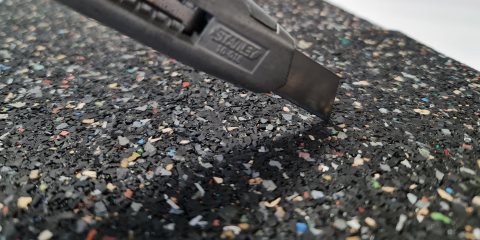Main page content
Entity view (Content)
CE-marking for Stravifloor Mat-F3e & Mat-F4.5e

Entity view (Content)
After careful evaluation, Stravifloor Mat-F3e and Stravifloor Mat-F4.5e roll-out isolation solutions have been granted the CE marking by the European Technical Assessment (ETA) body. The awarded ETA-22/0578 label confirms that these types of underlayment are conform to the Construction Products Regulations of the different European Union member states thereby proving to customers that these solutions meet the technical requirements of a construction product. This means that both Mat-F3e and Stravifloor Mat-F4.5e can be used without restrictions throughout the European market, including public buildings.
Stravifloor Mat-F3e and Stravifloor Mat-F4.5e resilient acoustic underlayments are made of an agglomerated recycled styrene butadiene rubber (SBR) mixed with a polyurethane (PU) elastomer bonding agent for impact noise insulation for both glued and non-glued types of flooring (e.g. Luxury Vinyl Tile (LVT), laminate or ceramic).
Often, the acoustic performance of a floor system with a limited overall build-up height needs to be improved. In these cases, the use of an acoustic mat installed directly under the floor covering is the only solution. By combining Stravifloor Mat-F3e or Stravifloor Mat-F4.5e with LVT, laminate or even ceramic tiles, a floating floor system with extremely low profile can be achieved. This system has been shown to reduce noise levels by up to 19 dB and provide consistently high impact sound insulation for decades.
Stravifloor Mat-F3e and Stravifloor Mat-F4.5e were assessed according to the Basic Work Requirements, and in compliance with the European Assessment Document (EAD) 040048-01-0502.
The many performance aspects that were tested are all listed in the solution datasheets and ETA report. These include among others, reaction to fire, dynamic stiffness, impact noise reduction, geometry, compressibility, compressive strength, deformation under a specific load and temperature, resistance to breaking and thermal resistance.
In addition, the substantive emission and/or release of hazardous substances has been assessed, considering that both solutions are never in direct contact with the indoor air, but may nevertheless, have potential effects on the indoor air quality. In particular, the emission of volatile organic compounds or so-called VOCs, semi-volatile organic compounds (SVOCs), specific organic compounds such as polycyclic aromatic hydrocarbons (PAHs) and benzo(a)pyrene (B[a]P) and the content of nitrosamines were assessed in accordance with the applicable standards.
The Stravifloor Mat-F3e and Stravifloor Mat-F4.5e setups that were tested are now documented on our online portal Stravi-dB. Here you can find more detailed information on the precise setup, the performance results and more. In addition to our own datasheets and spread sheets with acoustical data, you can download the official lab reports here as well.